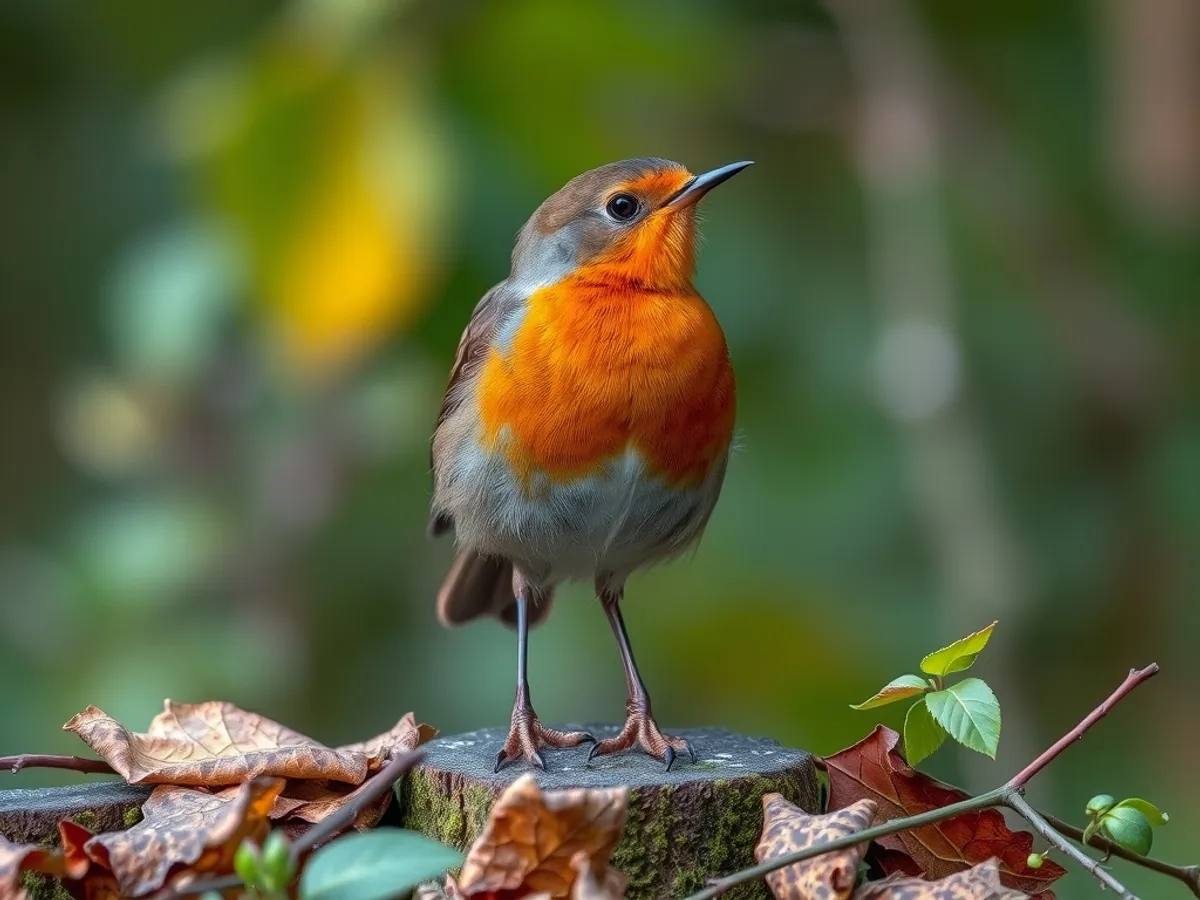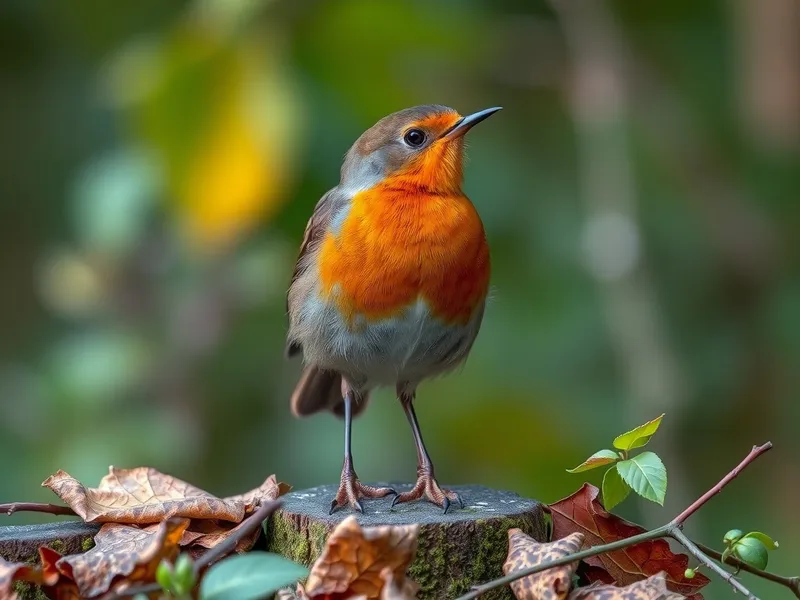
American Robin
Turdus migratorius

Meet the American Robin
The American Robin is a familiar songbird widely distributed across North America, recognized by its orange-red breast, gray upperparts, and cheerful song. This bird is highly adaptable, inhabiting woodlands, gardens, parks, and urban areas. American Robins are known for their migratory behavior, often heralding the arrival of spring in many regions. They feed primarily on earthworms and insects but will also eat fruits and berries, especially in winter. Their cup-shaped nests are commonly built in trees or on structures close to human activity.
Classification
Bird
Habitat
Woodlands, gardens, parks, and urban areas
Diet
Omnivore
Lifespan
2-6 years in the wild
Conservation
Least Concern
Weight
77-85 grams
📖Fascinating Facts
Distinctive Eggs
American Robin eggs are a striking shade of blue, often called 'robin's egg blue,' and are easily recognized in their nests.
Familiar Song
Their clear, whistling song is one of the most recognizable bird calls in North America and is often heard at sunrise and sunset.
Widespread Range
The American Robin breeds throughout most of North America, from Alaska and Canada down to Mexico, and migrates south in winter.
📋Detailed Description
The American Robin (Turdus migratorius) is a medium-sized songbird, measuring 23–28 cm (9–11 in) in length with a wingspan of 31–41 cm (12–16 in) and an average weight of 77–85 g (2.7–3.0 oz). Adults display a distinctive orange-red breast, gray-brown upperparts, a white throat streaked with black, and a broken white eye ring. Males are generally more vividly colored than females, which tend to have paler underparts and less contrast. Juveniles are spotted on the breast and have a more mottled appearance. The robin's bill is yellow with a slight dark tip, and its legs are slender and dark. American Robins are highly adaptable, thriving in a wide range of habitats from dense forests to suburban lawns and city parks. They are diurnal, foraging primarily on the ground for invertebrates and switching to fruit and berries in colder months. Their melodious, whistling song is a familiar sound across North America, especially at dawn and dusk. Robins are known for their strong migratory behavior, forming large flocks in winter and dispersing into breeding territories in spring. Their nests are constructed from mud and grasses, typically placed in trees, shrubs, or on human-made structures. The species exhibits a high degree of site fidelity, often returning to the same breeding and wintering areas year after year.
💡 Did you know?
American Robins sometimes get intoxicated from eating fermented berries in late autumn.
🔬Research & Sources
Wikipedia Summary
The American robin is a migratory bird of the true thrush genus and Turdidae, the wider thrush family. It is named after the European robin because of its reddish-orange breast, though the two species are not closely related, with the European robin belonging to the Old World flycatcher family. The American robin is widely distributed throughout North America, wintering from southern Canada to central Mexico and along the Pacific coast.
Last Modified: 5/25/2025
🎭Behavior & Social Structure
American Robins are primarily ground foragers, using a combination of visual and auditory cues to locate earthworms and insects. They exhibit a characteristic 'run-and-stop' foraging pattern, pausing to tilt their heads and listen for prey. During the breeding season, robins are territorial and aggressive, especially males, who defend their nesting area with song and physical displays. Outside the breeding season, they become more social, forming loose flocks that can number in the hundreds or even thousands, particularly at communal roosts. Robins are known for their early morning and late evening singing, which plays a role in territory establishment and mate attraction. They are also vigilant against predators, employing alarm calls and mobbing behaviors. Bathing and preening are frequent, helping maintain feather condition. In winter, their diet shifts heavily toward fruit, and they may travel considerable distances in search of food sources.
👶Reproduction & Life Cycle
The breeding season for American Robins typically begins in March or April, varying with latitude and local climate. Robins are socially monogamous within a breeding season, though extra-pair copulations occur. Courtship involves song, display flights, and food offerings by the male. Females build the nest, often in trees or shrubs 1–8 m (3–26 ft) above ground, using grasses, twigs, and mud. Clutch size ranges from 3 to 5 pale blue eggs, with the female incubating them for 12–14 days. Both parents feed the altricial chicks, which fledge at 13–15 days old. Robins may raise two or even three broods per season, especially in southern parts of their range. High nest predation rates (by squirrels, snakes, corvids, and domestic cats) are partially offset by this multiple-brooding strategy.
🛡️Adaptations & Survival
American Robins possess several adaptations for survival in variable environments. Their acute vision and ability to detect earthworm movement underground are key foraging adaptations. The species' flexible diet allows it to exploit both animal and plant food sources, supporting survival in diverse habitats and seasons. Their migratory behavior is finely tuned to photoperiod and temperature, enabling them to track resource availability across vast geographic ranges. Robins' strong legs and feet are well-suited for terrestrial foraging, while their flight is agile and direct, aiding in predator evasion. The construction of sturdy, mud-reinforced nests helps protect eggs and chicks from weather and some predators. Their melodious song serves both to attract mates and defend territory, while alarm calls and flocking behaviors enhance predator detection and deterrence.
🎨Cultural Significance
The American Robin holds a prominent place in North American culture and folklore, often symbolizing the arrival of spring and renewal. Its song and presence are celebrated in literature, music, and art, and it is the state bird of Connecticut, Michigan, and Wisconsin. The robin's blue eggs are iconic and have inspired the term 'robin's egg blue' in popular culture. In various Native American traditions, the robin is associated with joy, hope, and new beginnings. The bird's approachable nature and frequent presence in gardens and yards have made it a familiar and beloved figure in both rural and urban settings.
🔬Recent Research & Discoveries
Recent research on American Robins has focused on their migratory ecology, including the use of geolocators and stable isotope analysis to map migration routes and wintering grounds. Studies have examined the impacts of urbanization on breeding success, revealing that robins can adapt to urban environments but may experience higher nest predation and exposure to pollutants. Investigations into their role as hosts for West Nile virus have highlighted their importance in disease ecology. Ongoing research also explores the effects of artificial light and noise on robin behavior and reproductive timing. Genetic studies are clarifying subspecies boundaries and population structure across North America.
🎥Wildlife Videos

5 Lovable things About the American Robin
The quintessential early bird, American Robins are common sights on lawns across North America, where you often see them ...
Lesley the Bird Nerd

Tragedy & Triumph - An American Robin Documentary
Tragedy & Triumph - An American Robin Documentary Beginning in April of 2012 I began recording nests that were built on my ...
MrMusikyle

Birds Of US | Most Beautiful Birds In The United States | Wildlife Documentary | BBTV Official
Welcome to BBTV Official, In this celebration of avian splendor, we delve into the lives of the most beautiful birds across the United ...
BBTV Official

The American Robin Migration- Mini documentary, food, habitat, attracting them to your yard
To support my channel you can donate at : Patreon.com/FloridaKeysBirding Buy canvas prints and other products from my photos ...
Florida Keys Birding, and Wildlife

Most People Dont Know These 8 Facts About ROBINS
Robins are a familiar garden bird, so it may surprise you that not everything about them is common knowledge. In this video I ...
A Shot Of Wildlife

American Robin - HD Mini-Documentary
Transcript: "The American Robin is a symbol of spring. It is among the first North American birds to breed and lay eggs each year.
James Knott
🌍Habitat Information
The American Robin typically inhabits Woodlands, gardens, parks, and urban areas environments. American Robins have adapted to their environments with specialized features and behaviors.
Primary Habitat:
Woodlands, gardens, parks, and urban areas
More detailed habitat information will be available soon.
🛡️Conservation Status
The American Robin is currently classified as Least Concern. Conservation efforts are crucial for preserving this species for future generations.
Common Threats:
- 🏠Habitat loss and fragmentation
- 🌡️Climate change impacts
- 🎯Hunting and poaching
- 🏭Human-wildlife conflict
⚠️Threats & Conservation Challenges
While the American Robin is currently listed as Least Concern and remains abundant, it faces several localized threats. Habitat loss due to urbanization and intensive agriculture can reduce nesting and foraging sites. Pesticide use, particularly insecticides and herbicides, can reduce food availability and cause direct poisoning. Collisions with windows and vehicles are significant sources of mortality, especially in urban areas. Climate change may alter migratory timing and food resource availability, potentially impacting breeding success. Despite these challenges, the species' adaptability and broad range have allowed it to maintain stable or even increasing population trends across most of its range.
🔬Scientific Classification
Scientific Name
Turdus migratorius
Classification Hierarchy
🔍 About Taxonomic Classification
Taxonomic classification is a hierarchical system used by scientists to classify and organize living organisms based on shared characteristics and evolutionary relationships.
The system moves from broad categories (Kingdom) to increasingly specific ones, with each animal's scientific name typically consisting of its Genus and species.
📝Community Notes
Share your observations and insights about the American Robin with our community of wildlife enthusiasts.
Join Our Community
Sign in to share your observations and connect with fellow wildlife enthusiasts.
Sign In to ContributeNo community notes yet
Be the first to share your observations about the American Robin!
Explore American Robin
Select a tab above to learn more about this amazing animal.
📸Photo Gallery
No photos available for this animal yet.
🌟Discover More Wildlife
Continue your journey of discovery with more fascinating animals from our database
